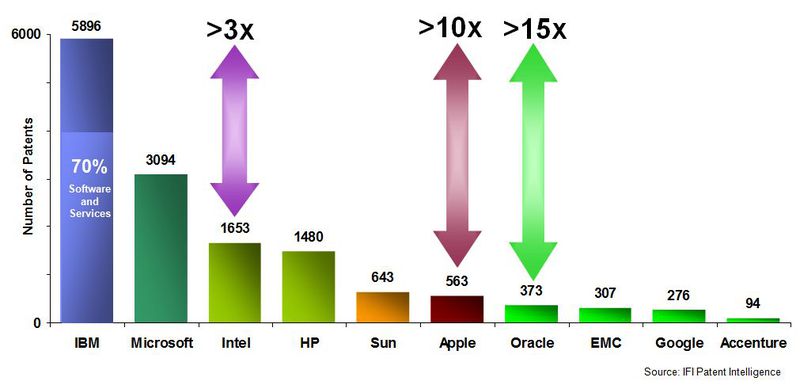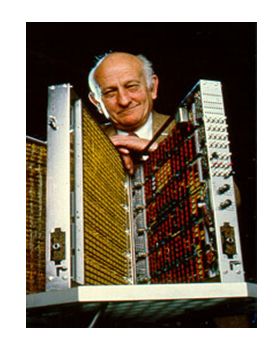And we also make calculators

IBM remains one of the most innovative companies in the IT industry, despite the fact that by universal standards it has long become a gray-haired old man, showing the way to young competitors. But it is unlikely that any other corporation could gather within its walls as much knowledge and their actual equivalent - patents as International Business Machines. Of the nearly 6,000 inventions, about 70% of the mass is accounted for by developments in the field of software and services, which we try to improve and modernize every day.
However, the division of the company dealing with Power processors and servers has not been forgotten - in fact, it remains one of the most fruitful areas of IBM’s activity and in 2010 alone, engineers registered more than 100 patents related to the central processors and their logic . $ 6 billion is invested annually in this area (Research & Development) - it is definitely interesting to see what such funds are spent on and what kind of product is obtained as a result.

IBM's microprocessor innovation is bestowed on RISC's founding father- John Coke. It is thanks to his intelligence that IBM-compatible architecture has become the main industry standard decades ago, and his legacy allows the company to remain at the forefront of technological progress.
The architecture of RISC, and indeed the entire industry, has come a long way from paper-based circuits and room-sized machines to ultra-compact computer-on-chip solutions, and processors using a shortened set of instructions are used everywhere: in smartphones, game consoles, workstations. Speaking specifically about the IBM Power line, the six generations, replacing one another from the nineties, brought the Power 7 chip to a high level of reliability.
The differences in the requirements that were made by the customers of the server (if computers of that time can generally be attributed to this category) at the time of Kok and today, after decades, are enormous. IBM loves to compare the purchase of a workstation or the data center equipment with the choice of a car: the buyer is interested in whether he gets up in bad weather and if he gets up at all (fault tolerance), how many people will get into it (scalability), how much fuel is required (energy efficiency), acceleration to 100 km / h (productivity), not to mention the image component. Therefore, most buyers of serious equipment: both computer and automobile, think in the same categories and look for, in a sense, a middle ground.

IBM Power 7 of the latest model is the optimal solution that technical directors of young companies are looking for today to equip their data centers, power cloud power, and many other solutions: 4, 6, or 8 cores per socket; performance from 2.4 to 4.14 Ghz; 4 threads per core; eDRAM L3 cache; dynamic optimization of energy consumption - all this is designed to satisfy any consumer needs in any system, from the initial configuration to high-end workstations or high-load servers.

By the way, 32 Mb L3 cache is one of the most interesting innovations in the Power 7 model. Firstly, it is a high-density eDRAM (three times higher packing density compared to SRAM) which is characterized by low power consumption (in operating modes, the gap is x5 from the SRAM), lower latency (x6 in comparison with the off-chip memory), and used to proc eed bandwidth (x2 in comparison with the off-chip memory). All this leads to the fact that the Power 7 cache allows 250 times fewer errors compared to competitors and previous processor models.
The Power line also has a Turbo Core operating mode that changes the flow of processes inside the chip: only 4 cores remain, which are given the entire cache of the third level (that is, the amount of memory per core increases by 2 times, which leads to a performance increase in computing at the level of 17-22%), and the core clock speed increases. In this mode, the processor is able to process more instructions in a short period of time, after which it will again return to normal mode. Along with the turbo mode, an adaptive system for optimizing energy consumption also operates, which means that sharp jumps in performance will not critically affect the energy consumption of all systems - this quality will be appreciated by engineers working with high-level and fault-tolerant infrastructures.
In all, Power 7 remains a good solution, optimized for specific tasks - you yourself can evaluate the range of equipment provided to customers on the IBM Power website . Here are the entry-level servers, equipment for cloud providers and their exact opposite - ultra-modern data processing cabinets that are vaguely reminiscent of the Watson supercomputer , which works, by the way, on the same processors.
All the positive qualities and distinctive features of the Power line will certainly be reflected in the processor of the next, already eighth generation. In addition to the reduced manufacturing process technology (up to fashionable 22 nm.) And the next-generation computer-on-chip system, it will be possible to find a larger built-in cache than now, and, of course, more productive and fault-tolerant cores.

